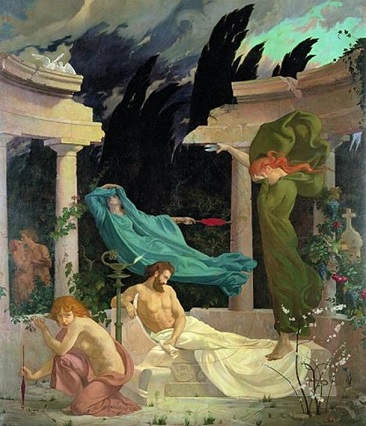
The Three Fates (Moirai)

The ancient Greeks believed that many aspects of a person’s life were determined by the three mythical women known as Fates. These were three sister goddesses that appeared in Greek and Roman mythology and were believed to have “spun out” a child’s destiny at birth.
They determined when life began, when it ended, and everything in between. At the birth of each man they appeared spinning, measuring, and cutting the thread of life. However not everything was inflexible or pre-determined. A man destined to become a great warrior one day could still choose what he wanted to do on any given day. The gods could simply intervene with decisions that could be helpful or harmful. In a sense, they controlled the metaphorical life of every mortal born.
Known as Moirai or Moerae in Greek Mythology and Fata or Parcae by the Romans, the Fates were comprised of three women often described as elderly, stern, severe, cold and unmerciful. Their names in Greek were Clotho, (“the spinner”), Lachesis (“the apportioner”) and Atropos (“the inevitable”). The Roman names for them were Nona, Decuma and Morta. While Greek portrayal of these deities was that of grave and busy maidens, Romans often showcased them as being mean or denying humans their hopes and desires.
The first Moirai goddesses, Clotho, meaning spinner, spun the thread of life. She is depicted as a maiden and is often seen carrying a spindle or a roll (the book of Fate). Lachesis, meaning unbending, measured the thread of life which determined how long one would live. She appeared as a matron with a staff with which she points to the horoscope on a globe. Atropos meaning “inexorable” or “inevitable” was the cutter of the thread of life and appeared as a crone.
She chose the manner of each person’s death and when their time was up, cut their life-thread with shears. The smallest of the three, she is also characterized as the most terrible. In various accounts, the three goddesses are shown with staffs, scepters or wearing crowns as symbols of dominion. They all lived in Zeus’s palace on Mount Olympus.
At the birth of a boy, the Moirai spun out the thread of his future life, followed his steps, directing the consequences of his actions according to the counsel of the gods. The Fates did not interfere in human affairs directly but availed themselves of intermediate causes, and determined the lot of mortals conditionally. Man was allowed to exercise a certain influence upon them. As man's fate was determined at his death, the goddesses of fate became the goddesses of death, ‘Moirai.
It is likely that Moirai controlled the fates of both mortals and gods alike and they have even been described as being more powerful than the gods. Homer wrote in the Iliad, “it was the will of fate that the Greeks destroy Troy, when Rumor and Panic caused the Greeks to want to flee. Aeneas was fated to go to Italy, despite the best efforts of Hera. Hera's actions in attempting to defy fate led to a premature death of Dido, the queen of Carthage. Since her thread was not cut to so short a length, she would not die even though a dagger had pierced her breast.”
While Zeus reigned as the supreme Greek deity, he was subject to the decisions of the Fates and the driver of destiny rather than the source of it. However, Zeus, if he chose, had the power of saving those who were already at risk of being seized by their fate.
The personification of fate as the Moirai, is first clearly described in Hesiod's epic poem the Theogony (ca. 700 B.C.E.). Hesiod presents the Moirai as the daughters of Zeus and the goddess Themis. They are imagined as working the womanly task of spinning - drawing out a thread of yarn that represents each person's life. Into the thread may be woven sorrow, wealth, travel and the like. It is uncertain who the parents of the Morai were.
In some myths, they were the daughters of Zeus and the Titan goddess Themis, the goddess of divine order. Some say they were the daughters of Erebus (Darkness) and Nyx (or of Zeus and Themis). In some instances, they were related to Ananke, the personification of necessity.
The idea of three goddesses linked with one’s destiny appears in various forms in mythology. The Greeks recognized another triad of goddesses called the Horae, who were associated with Aphrodite. The Norse called their three Fates the Norns and were sometimes referred to as the Weird Sisters, from the Norse word wyrd, meaning "fate."
The Celts had three war goddesses, known as the Morrigan, who determined the fate of soldiers in battle. The idea or image of a triple goddess may be linked to very ancient worship of a moon goddess in three different forms: a maiden (the new moon), a mature woman (the full moon), and a crone (the old moon).
The Fates were popular figures of cult worship in Greece and evidence suggests there were sanctuaries to them in major cities such as Corinth, Sparta, and Thebes. Offerings were also made to the Fates during festival times in Athens, Delphi, Olympia, and Sicyon and they are thought to have been of benefit during the harvest season. Today, the origin and meaning of the word ‘fate’ is traced to the mythology of these three powerful goddesses.
[1]
Sources
Our Mobile Application
Check out Our Mobile Application "Ancient Greece Reloaded"


